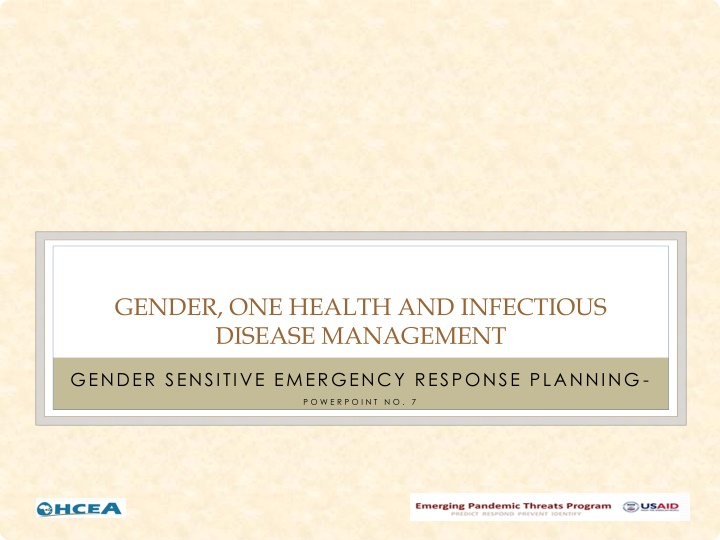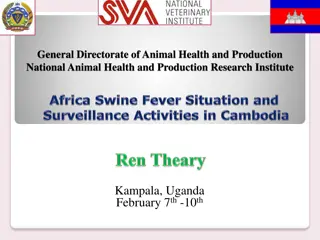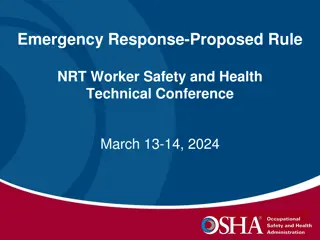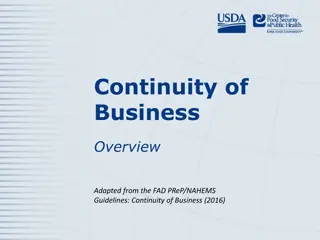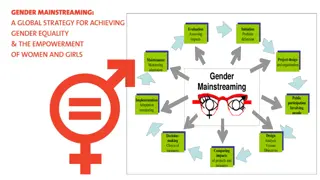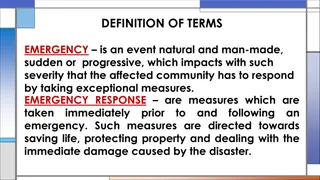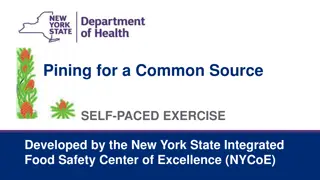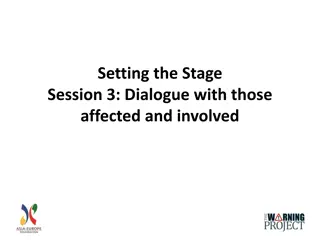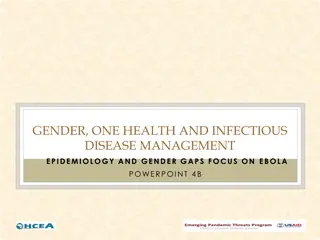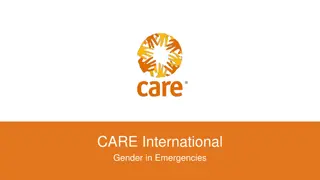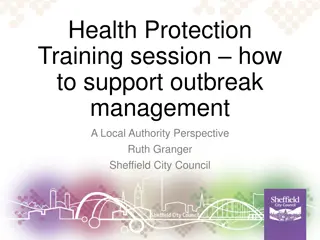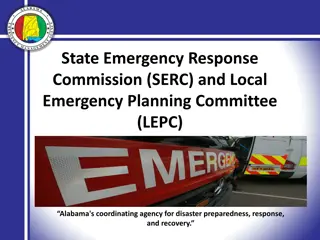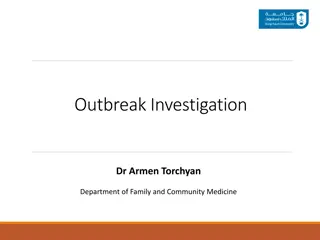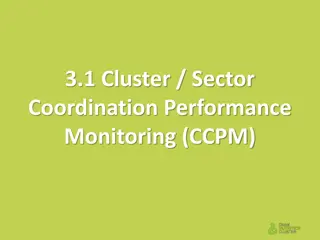Gender-Sensitive Disease Outbreak Emergency Response
Infectious disease epidemics from wildlife and animals are concerns for human health. Learn to create gender-sensitive emergency response plans, advocate for One Health change, and deliver risk communication.
Download Presentation

Please find below an Image/Link to download the presentation.
The content on the website is provided AS IS for your information and personal use only. It may not be sold, licensed, or shared on other websites without obtaining consent from the author.If you encounter any issues during the download, it is possible that the publisher has removed the file from their server.
You are allowed to download the files provided on this website for personal or commercial use, subject to the condition that they are used lawfully. All files are the property of their respective owners.
The content on the website is provided AS IS for your information and personal use only. It may not be sold, licensed, or shared on other websites without obtaining consent from the author.
E N D
Presentation Transcript
GENDER, ONE HEALTH AND INFECTIOUS DISEASE MANAGEMENT GENDER SENSITIVE EMERGENCY RESPONSE PLANNING- P O W E R P O I N T N O . 7
DAY FOUR LEARNING OBJECTIVES Create and implement gender-sensitive disease outbreak emergency response plans across all phases of a response. Advocate for One Health change. Prepare and deliver gender-sensitive risk communication.
DAY FOUR LEARNING OBJECTIVES Create and implement gender-sensitive disease outbreak emergency response plans across all phases of a response. Advocate for One Health change Prepare and deliver gender-sensitive risk communication.
INTRODUCTION Infectious disease epidemics of great concern to human health are emerging from wildlife and domestic animals. Barriers between humans, wildlife and livestock populations are rapidly breaking. This has mainly occurred more frequently in the tropics where there is limited resources for disease prevention and control. Among recent examples of these epidemics are avian influenza, Ebola outbreaks in Uganda and DRC, monkey pox in the DRC, Yellow Fever in Uganda, and Nipah virus outbreaks in Southeast Asia. These are outbreaks of global importance-pandemics.
INTRODUCTION (CONTINUED) Most capacity building efforts to identify, investigate and respond to emerging infectious diseases have focused on supporting public health agencies. However, responding effectively to these diseases requires engagement of and coordination with a diversity of professions and stakeholders in both human and animal health, as well as social and environmental sciences. To improve efficiency and effectiveness of interventions, gender ought to be mainstreamed in all the planning and operation processes of the disease outbreak control.
FUNDAMENTALS OF DISEASE OUTBREAK CONTROL An epidemic/outbreak is the occurrence of a number of cases of a disease that is unusually large or unexpected for a given place and time. Outbreaks can spread very rapidly in emergency situations and lead to high morbidity and mortality rates. The aim is to detect an outbreak as early as possible so as to control the spread of disease among the population at risk.
STEPS IN CONTAINING A DISEASE OUTBREAK Preparation Detection Response Evaluation
PREPARATION Preparation Detection Response Evaluation Two forms of preparation (planning) Contingency planning Outbreak response planning Contingency planning means preparing for predictable and quantifiable crises, OR It may mean preparing for unexpected and unwelcome events. The aim of contingency planning is to minimize the impact of a foreseeable event before it occurs.
PREPARATION (CONTINUED) Planning for zoonotic disease outbreaks ought to be carried out within the framework of One Health with deliberate efforts to consider and address gender issues. The following are important in outbreak response planning/preparation: Formation of a cross-sector, national coordination team Coordination meetings Surveillance system- daily outbreak reports A profile of the resources, skills and activities required Stockpiles the necessary drugs/vaccines Contingency plans for isolation facilities Laboratory support
DETECTION AND RISK ASSESSMENT Detection Preparation Response Evaluation The surveillance system must have an early warning mechanism for epidemic-prone diseases. Inform ministries and international organizations concerned - Ministries of Health, Animal industry, WHO, OIE. Take appropriate specimens. Produce weekly/daily reports.
RESPONSE Preparation Detection Response Evaluation Confirm the outbreak. Activate the outbreak control team. Investigate the outbreak. Control the outbreak.
EVALUATION Preparation Detection Response Evaluation Assess appropriateness and effectiveness of containment measures. Assess timeliness of outbreak detection and response. Change public health policy if indicated. Write and disseminate outbreak report.
EMERGENCY DISEASE OUTBREAK RESPONSE PREPAREDNESS Should be gender sensitive throughout the process. An outbreak investigation and control plan must be prepared. Staff trained on the principles of outbreak investigation and control, including relevant treatment protocols. Reserve stocks of essential drugs, medical supplies, vaccines and basic protection material are available and can be procured rapidly.
EMERGENCY DISEASE OUTBREAK RESPONSE PREPAREDNESS (CONTINUED) Sources of vaccines for relevant outbreaks are identified for rapid procurement and use. Mechanisms for rapid procurement must be established. Sites for the isolation and treatment of infectious patients are identified in advance. A laboratory is identified, whether locally, regionally, nationally or in another country, that can provide confirmation of diagnoses.
WHY GENDER RESPONSIVENESS Gender affects norms, roles and responsibilities, decision-making and access to resources. These in turn affect occupation, care work for children and ill family members, housework, care for farm animals). Sex on the other hand impacts disease responsiveness through anatomy, immune system, and pregnancy.
WHY GENDER RESPONSIVENESS (CONTINUED) Gender and sexual dynamics must thus be factored in disease prevention and control programs. Gender is likely to influence: vulnerability to disease response to disease Exposure to pathogens These in turn influence: Disease incidence Disease duration Disease severity: (morbidity, mortality, disability)
WHY GENDER RESPONSIVENESS (CONTINUED) There is thus need for: Surveillance data on pregnancy status, especially for new diseases. Gender biases in surveillance data. Male-female differences in symptoms and diagnostic criteria. Gender differences in use of health facilities. Sex and gender differences change over the life cycle. The proportion of males and females in the population varies with age. Gender differences are not generalizable from place to place. Must carry out a thorough gender analysis.
